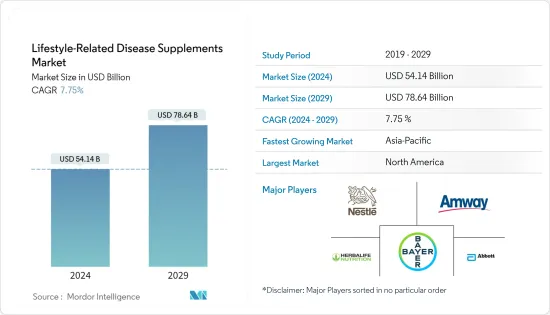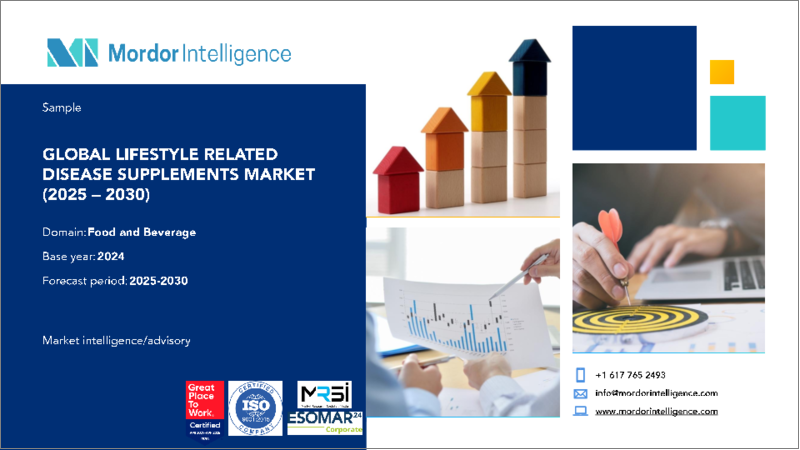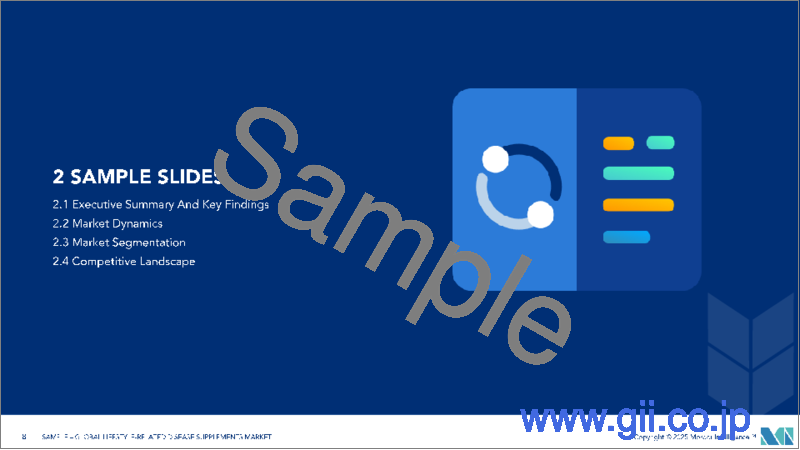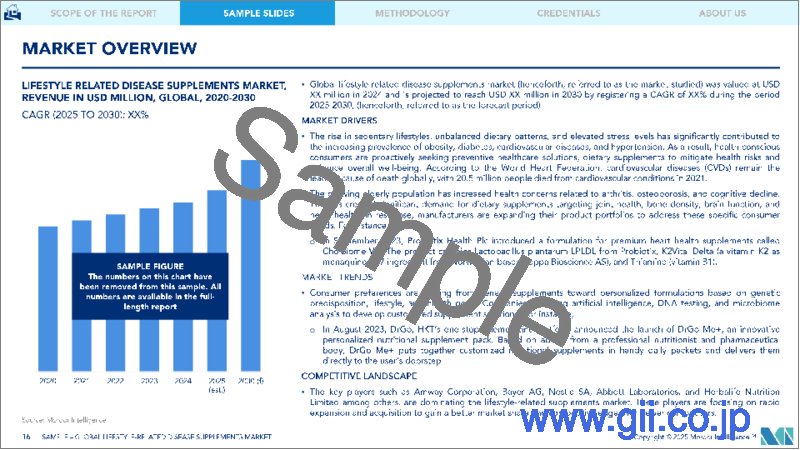|
|
市場調査レポート
商品コード
1437488
生活習慣病サプリメント:市場シェア分析、業界動向と統計、成長予測(2024-2029)Lifestyle-Related Disease Supplements - Market Share Analysis, Industry Trends & Statistics, Growth Forecasts (2024 - 2029) |
||||||
カスタマイズ可能
適宜更新あり
|
|||||||
| 生活習慣病サプリメント:市場シェア分析、業界動向と統計、成長予測(2024-2029) |
|
出版日: 2024年02月15日
発行: Mordor Intelligence
ページ情報: 英文 212 Pages
納期: 2~3営業日
|
- 全表示
- 概要
- 目次
生活習慣病サプリメント市場規模は、2024年に541億4,000万米ドルと推定され、2029年までに786億4,000万米ドルに達すると予測されており、予測期間(2024年から2029年)中に7.75%のCAGRで成長します。

パンデミックにより、健康補助食品に対する消費者の意識の高まりとヘルスケアへの支出の増加により、生活習慣病に対する需要が高まっています。さらに、パンデミック期間中、ロックダウンの延長により消費者は自宅で過ごす時間が増え、不安、ストレス、その他の種類の病気をさらに誘発します。その結果、市場における健康補助食品の売上が増加します。その後、ビタミンCは免疫機能の改善に役立つため、パンデミック期間中に市場で大幅な成長を遂げました。したがって、市場関係者は、市場シェアを獲得し、市場での存在感を高めるために、このカテゴリーに投資し、新製品を発売しています。たとえば、2021年にLife Extensionは、24時間システム内に留まり、従来のビタミンCサプリメントよりも7倍生体利用効率が高い24時間リポソームヒドロゲル処方を備えた革新的な新しいビタミンCサプリメントの発売を発表しました。さらに、パンデミック中にライフスタイルの選択肢として健康の重要性が高まったことも、調査対象市場の健康分野に参入する多くの企業を惹きつけました。
長期的には、不健康な食事や運動不足などのライフスタイル行動の変化により、世界中の消費者の間でライフスタイル関連の問題が蔓延しています。その結果、健康補助食品の消費量が増加します。したがって、消費者の予防的健康管理への移行と生活習慣病の負担に対する意識の高まりが、世界市場の成長を推進する主な要因となっています。
さらに、精神疾患やキャリア重視のストレスの多いライフスタイルにより、認知、精神、気分に関するサプリメントの需要が増加しており、その結果、生活習慣病サプリメント市場の成長を促進しています。
生活習慣病サプリメント市場動向
予防ヘルスケア製品の需要の拡大
消費者のライフスタイルの変化とそれに関連する体の食事代謝への影響により、とりわけ糖尿病、肥満、心臓病、脳卒中などの病気の発症率が増加しています。さらに、労働人口の増加と多忙なライフスタイルは、生活習慣病の増加に悪影響を及ぼしています。たとえば、長時間座っていることに伴う身体活動の不足は、便秘、膨満感、消化不良などの消化器系の健康上の問題を引き起こす可能性があります。その結果、消費者は主に、これらの健康問題を克服するための消化器系の健康補助食品を求めています。
生活習慣病の影響で、消費者は健康的なライフスタイルを志向する傾向が強くなり、年齢を重ねても健康状態を維持するために栄養補助食品の摂取が増えています。病気の有病率が増加しているため、心臓の健康と骨の健康に関するサプリメントは世界中の消費者の間で広く消費されています。たとえば、世界保健機関によると、心血管疾患は世界の主要な死因であり、毎年推定1,790万人の命を奪っています。このように、ヘルスケア費の高騰と予防ヘルスケアソリューションの恩恵により、消費者は自分の健康を自分で管理し、健康情報を入手し、十分な情報に基づいて生活習慣病サプリメントの購入決定を下すようになっています。
アジア太平洋は最も急速に成長している地域です
生活習慣病関連サプリメントの成長は主に、この地域における健康補助食品に対する消費者の意識の高まりと相まって、慢性疾患の発生率の増加によって推進されています。人口の可処分所得の増加により、この地域の健康増進製品に対する消費者の支出が増加し、それが市場の成長を促進しています。さらに、インド、中国、日本などの新興諸国国では人口の高齢化が顕著であるため、近年、サプリメントの需要が増加しています。例えば、米国国勢調査局によると、65歳以上のアジア人の人口は推定4億1,400万人で、2020年の米国の総人口(3億3,140万人)よりも約20%多かった。この地域の生活習慣病サプリメント市場特にハーブやアーユルヴェーダの抽出物ベースの製品に対して、重要な投資機会を提供すると予想されています。これは、インドや東南アジア諸国で原材料が豊富に入手できるためです。さらに、新旧のプレーヤー間のパートナーシップにより、これらの国の市場の成長が強化される可能性があります。
生活習慣病サプリメント業界の概要
世界の生活習慣病サプリメント市場には、アムウェイコーポレーション、バイエルAG、ネスレSA、アボットラボラトリーズ、ハーバライフニュートリションリミテッドなどの市場プレーヤーが含まれています。サプリメント市場は既存企業も含めると非常に広い市場です。 FDAの規制が蔓延しているため、大手企業が優位に立って市場を独占し続けています。また、世界の大手企業は地理的な範囲が広く、消費者の間で高いブランド認知度を持っているため、優位性を持っています。この地域の主要企業は、自社の製品ポートフォリオを強化し、幅広い顧客に対応し、新しい地域に拡大するための戦略としてイノベーションに注力してきました。たとえば、2022年3月、中国のサプリメントブランドであるByHealthは、バイオイベリカ成分を特徴とするコラーゲン関節健康製品を発売しました。この製品は、膝の不快感と機能を改善することが臨床的に証明されているネイティブ II型コラーゲンのブランド成分Collavant n2を特徴としています。
その他の特典
- エクセル形式の市場予測(ME)シート
- 3か月のアナリストサポート
目次
第1章 イントロダクション
- 調査の前提条件と市場の定義
- 調査範囲
第2章 調査手法
第3章 エグゼクティブサマリー
第4章 市場力学
- 市場促進要因
- 市場抑制要因
- ポーターのファイブフォース分析
- 新規参入業者の脅威
- 買い手の交渉力
- 供給企業の交渉力
- 代替製品の脅威
- 競争企業間の敵対関係の激しさ
第5章 市場セグメンテーション
- 製品タイプ別
- 心臓の健康に関するサプリメント
- 骨と関節の健康サプリメント
- 消化器系の健康補助食品
- 脳の健康に関するサプリメント
- その他のサプリメント
- 形状別
- 粉末
- カプセル
- その他
- 流通チャネル別
- スーパーマーケット/ハイパーマーケット
- 薬局・ドラッグストア
- オンライン小売店
- その他の流通チャネル
- 地域別
- 北米
- 米国
- カナダ
- メキシコ
- 北米のその他の地域
- 欧州
- 英国
- ドイツ
- スペイン
- フランス
- イタリア
- ロシア
- その他欧州
- アジア太平洋
- 中国
- 日本
- インド
- オーストラリア
- その他アジア太平洋地域
- 南米
- ブラジル
- アルゼンチン
- その他南米
- 中東とアフリカ
- サウジアラビア
- 南アフリカ
- その他中東とアフリカ
- 北米
第6章 競合情勢
- 最も採用されている戦略
- 市場シェア分析
- 企業プロファイル
- Abbott Laboratories
- Bayer AG
- Amway Corporation
- Nestle SA
- Herbalife Nutrition Limited
- Otsuka Holdings inc.,
- Swanson Health Products
- Mega Lifesciences
- Nordic Naturals
- NOW Health Group Inc
第7章 市場機会と将来の動向
第8章 COVID-19の市場への影響
第9章 免責事項
The Lifestyle-Related Disease Supplements Market size is estimated at USD 54.14 billion in 2024, and is expected to reach USD 78.64 billion by 2029, growing at a CAGR of 7.75% during the forecast period (2024-2029).

The pandemic has raised the demand for lifestyle-related diseases due to the growing consumer awareness about health supplements and increasing expenditure on healthcare. Moreover, during the pandemic period consumers are spending more time at home due to the extended lockdown which further induces anxiety, stress, and other types of disease. As a result, it increases, the sales of health supplements in the market. Subsequently, the demand for vitamin C has witnessed massive growth in the market during the pandemic period as it helps to improve immune function. Thus, market players are investing in the category and launching new products to gain market share and increase their market presence. For instance, in 2021, Life Extension unveiled the launch of a new vitamin C supplement which is innovative with 24-hour liposomal hydrogel formula that stays in the system for 24 hours and is seven times more bioavailable than conventional vitamin C supplements. Moreover, the growing importance of health as a lifestyle choice during the pandemic also attracted many companies to enter the health segments of the market studied.
Over the long term, the prevalence of lifestyle-related problems has been increasing among the global consumer owing to the changing lifestyle behaviors including consumption of unhealthy diet, and physical inactivity. As a result, it raises the consumption of health supplements. Therefore, the consumer shift toward preventive health management practices and growing awareness about the burden of lifestyle disease is the major factor driving the growth in the global market.
Furthermore, the demand for cognitive, mental, and mood supplements is increasing due to mental illness and stressful career-focused lifestyles and in turn, fuels the growth of the lifestyle-related disease supplements market.
Lifestyle Related Disease Supplements Market Trends
Growing Demand for Preventive Health Care Products
The changing consumer's lifestyle and its related impact on the dietary metabolism of the body have resulted in the escalating rate of diseases such as diabetes, obesity, heart disease, and stroke among others. Moreover, the growing working population and hectic lifestyle have made an adverse effect on boosting lifestyle diseases. For example, the insufficient physical activity associated with prolonged sitting hours may lead to digestive health issues involving constipation, bloating, and indigestion. As a result, consumers are largely demanding digestive health supplements to overcome these health issues.
Owing to the result of lifestyle diseases, consumers are more inclined toward a healthy lifestyle and increasingly consume dietary supplements in order to maintain their health conditions even after ages. Heart health and bone health supplement are widely consumed among global consumers due to the increasing prevalence of disease rates. For instance, according to World Health Organization, Cardiovascular diseases are the leading cause of death globally taking an estimated 17.9 million lives each year. Thus, the rising healthcare costs and benefits of preventive healthcare solutions have encouraged consumers to take their health into their own hands, equipping themselves with health information and taking well-informed purchasing decisions on lifestyle-related disease supplements.
Asia-Pacific is the Fastest Growing Region
The growth in lifestyle-related disease supplements has largely been driven by the increasing incidence of chronic disease rates coupled with growing consumer awareness about health supplements in the region. The increasing disposable income among the population has raised the consumers' expenditure on health-enhancing products in the region which in turn, drives the market growth. Additionally, the demand for supplements in countries like India, China, and Japan has increased in recent years, owing to the considerable presence of the aging population in such developing countries. For instance, according to the United States Census Bureau, there were an estimated 414 million Asian people age 65 and older, about 20% higher than the total U.S. population (331.4 million) in 2020. The lifestyle-related disease supplements market in the region is anticipated to offer significant investment opportunities, especially for herbal and Ayurveda extract-based products. This is because of the ample availability of raw materials in India and Southeast Asian countries. Moreover, partnerships between old and new players will likely strengthen market growth in these countries.
Lifestyle Related Disease Supplements Industry Overview
The global lifestyle-related disease supplements market includes market player such as Amway Corporation, Bayer AG, Nestle SA, Abbott Laboratories, and Herbalife Nutrition Limited among others. The supplements market has a wide scope, considering the existing companies. With prevalent FDA regulations, the leading players have an upper edge and continue to dominate the market. Also, the major global players have a geographical reach and high brand awareness among consumers, giving them an upper hand. Major players in the region have been focusing on innovation as a strategy to strengthen their product portfolio, to cater a wide range of customers, and expand to new regions. For instance, in March 2022, ByHealth, China's supplement brand, launched a collagen joint health product featuring Bioiberica ingredients. The product features native type II collagen branded ingredient Collavant n2 which has been clinically shown to improve knee discomfort and function.
Additional Benefits:
- The market estimate (ME) sheet in Excel format
- 3 months of analyst support
TABLE OF CONTENTS
1 INTRODUCTION
- 1.1 Study Assumptions and Market Definition
- 1.2 Scope of the Study
2 RESEARCH METHODOLOGY
3 EXECUTIVE SUMMARY
4 MARKET DYNAMICS
- 4.1 Market Drivers
- 4.2 Market Restraints
- 4.3 Porter's Five Force Analysis
- 4.3.1 Threat of New Entrants
- 4.3.2 Bargaining Power of Buyers/Consumers
- 4.3.3 Bargaining Power of Suppliers
- 4.3.4 Threat of Substitute Products
- 4.3.5 Intensity of Competitive Rivalry
5 MARKET SEGMENTATION
- 5.1 By Product Type
- 5.1.1 Heart Health Supplements
- 5.1.2 Bone and Joint Health supplements
- 5.1.3 Digestive Health Supplements
- 5.1.4 Brain Health Supplements
- 5.1.5 Other Supplements
- 5.2 By Form
- 5.2.1 Powder
- 5.2.2 Capsules
- 5.2.3 Others
- 5.3 By Distribution Channel
- 5.3.1 Supermarkets/Hypermarkets
- 5.3.2 Pharmacies & Drug Stores
- 5.3.3 Online Retail Stores
- 5.3.4 Other Distribution Channel
- 5.4 By Geography
- 5.4.1 North America
- 5.4.1.1 United States
- 5.4.1.2 Canada
- 5.4.1.3 Mexico
- 5.4.1.4 Rest of North America
- 5.4.2 Europe
- 5.4.2.1 United Kingdom
- 5.4.2.2 Germany
- 5.4.2.3 Spain
- 5.4.2.4 France
- 5.4.2.5 Italy
- 5.4.2.6 Russia
- 5.4.2.7 Rest of Europe
- 5.4.3 Asia-Pacific
- 5.4.3.1 China
- 5.4.3.2 Japan
- 5.4.3.3 India
- 5.4.3.4 Australia
- 5.4.3.5 Rest of Asia-Pacific
- 5.4.4 South America
- 5.4.4.1 Brazil
- 5.4.4.2 Argentina
- 5.4.4.3 Rest of South America
- 5.4.5 Middle East & Africa
- 5.4.5.1 Saudi Arabia
- 5.4.5.2 South Africa
- 5.4.5.3 Rest of Middle East & Africa
- 5.4.1 North America
6 COMPETITIVE LANDSCAPE
- 6.1 Most Adopted Strategies
- 6.2 Market Share Analysis
- 6.3 Company Profiles
- 6.3.1 Abbott Laboratories
- 6.3.2 Bayer AG
- 6.3.3 Amway Corporation
- 6.3.4 Nestle SA
- 6.3.5 Herbalife Nutrition Limited
- 6.3.6 Otsuka Holdings inc.,
- 6.3.7 Swanson Health Products
- 6.3.8 Mega Lifesciences
- 6.3.9 Nordic Naturals
- 6.3.10 NOW Health Group Inc






